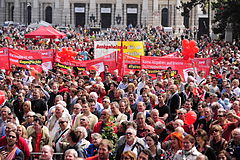 Achieving global nuclear disarmament is the highest disarmament priority of the United Nations. It was the subject of the General Assembly’s first resolution in 1946, which established the Atomic Energy Commission (dissolved in 1952), with a mandate to make specific proposals for the control of nuclear energy and the elimination of atomic weapons and all other major weapons adaptable to mass destruction. The United Nations has been at the forefront of many major diplomatic efforts to advance nuclear disarmament since. In 1959, the General Assembly endorsed the objective of general and complete disarmament. In 1978, the first Special Session of the General Assembly Devoted to Disarmament further recognized that nuclear disarmament should be the priority objective in the field of disarmament. Every United Nations Secretary-General has actively promoted this goal.
Achieving global nuclear disarmament is the highest disarmament priority of the United Nations. It was the subject of the General Assembly’s first resolution in 1946, which established the Atomic Energy Commission (dissolved in 1952), with a mandate to make specific proposals for the control of nuclear energy and the elimination of atomic weapons and all other major weapons adaptable to mass destruction. The United Nations has been at the forefront of many major diplomatic efforts to advance nuclear disarmament since. In 1959, the General Assembly endorsed the objective of general and complete disarmament. In 1978, the first Special Session of the General Assembly Devoted to Disarmament further recognized that nuclear disarmament should be the priority objective in the field of disarmament. Every United Nations Secretary-General has actively promoted this goal.
Yet, today around 12,512 nuclear weapons remain. Countries possessing such weapons have well-funded, long-term plans to modernize their nuclear arsenals. More than half of the world’s population still lives in countries that either have such weapons or are members of nuclear alliances. While the number of deployed nuclear weapons has appreciably declined since the height of the Cold War, not one nuclear weapon has been physically destroyed pursuant to a treaty. In addition, no nuclear disarmament negotiations are currently underway.
Meanwhile, the doctrine of nuclear deterrence persists as an element in the security policies of all possessor states and many of their allies. The international arms-control framework that contributed to international security since the Cold War, acted as a brake on the use of nuclear weapons and advanced nuclear disarmament, has come under increasing strain. On 2 August 2019, the United States’ withdrawal spelled the end of the Intermediate-Range Nuclear Forces Treaty, through with the United States and the Russian Federation had previously committed to eliminating an entire class of nuclear missiles. Furthermore, the Russian Federation announced on 21 February 2023 that it will suspend its participation in the Treaty on Measures for the Further Reduction and Limitation of Strategic Offensive Arms (“New START”). The extension of New START until February 2026 had provided an opportunity for the possessors of the two largest nuclear arsenals to agree to further arms control measures.
 The eight-hour movement to reduce the working day from 10 to eight hours began after the Civil War. It was a major aim of the National Labor Union, whose first congress met in 1866. By 1868 congress and six states passed an eight-hour legislation. In 1884 the National Federation of Organized Trades and Labor Assemblies decided to call for a general strike on May 1, 1886, to enforce demands for employers to observe the eight-hour day. In 1947, amidst the anti-Communist Cold War hysteria, the US Veterans of Foreign Wars renamed May 1 as « Loyalty Day » and a joint session of Congress later made the pronouncement official.
The eight-hour movement to reduce the working day from 10 to eight hours began after the Civil War. It was a major aim of the National Labor Union, whose first congress met in 1866. By 1868 congress and six states passed an eight-hour legislation. In 1884 the National Federation of Organized Trades and Labor Assemblies decided to call for a general strike on May 1, 1886, to enforce demands for employers to observe the eight-hour day. In 1947, amidst the anti-Communist Cold War hysteria, the US Veterans of Foreign Wars renamed May 1 as « Loyalty Day » and a joint session of Congress later made the pronouncement official.